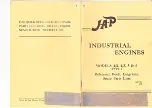
Not for
Reproduction
Copyright © Briggs & Stratton Corporation, Milwaukee, WI, USA. All rights reserved.
This manual contains safety information to make you aware of the hazards and risks
associated with engines and how to avoid them. It also contains instructions for the proper
use and care of the engine. Because Briggs & Stratton Corporation does not necessarily
know what equipment this engine will power, it is important that you read and understand
these instructions and the instructions for the equipment. Save these original instructions
for future reference.
Note: The figures and illustrations in this manual are provided for reference only and may
differ from your specific model. Contact your dealer if you have questions.
For replacement parts or technical assistance, record below the engine model, type, and
code numbers along with the date of purchase. These numbers are located on your engine
(see the
Features and Controls section).
Date of Purchase
Engine Model - Type - Trim
Engine Serial Number
Look for the 2D barcode located on some
engines. When viewed with a 2D-capable
device, the code will bring up our website
where you can access support information
for this product. Data rates apply. Some
countries may not have online support
information available.
Recycling Information
All packaging, used oil, and batteries should be recycled
according to applicable government regulations.
Operator Safety
Safety Alert Symbol and Signal Words
The safety alert symbol
is used to identify safety information about hazards that can
result in personal injury. A signal word (DANGER, WARNING, or CAUTION) is used with
the alert symbol to indicate the likelihood and the potential severity of injury. In addition, a
hazard symbol may be used to represent the type of hazard.
DANGER indicates a hazard which, if not avoided, will result in death or serious
injury.
WARNING indicates a hazard which, if not avoided, could result in death or serious
injury.
CAUTION indicates a hazard which, if not avoided, could result in minor or
moderate injury.
NOTICE indicates an situation that could result in damage to the product.
Hazard Symbols and Meanings
Meaning
Symbol
Meaning
Symbol
Read and understand the
Operator's Manual before
operating or servicing the unit.
Safety information about
hazards that can result in
personal injury.
Explosion hazard
Fire hazard
Meaning
Symbol
Meaning
Symbol
Toxic fume hazard
Shock hazard
Noise hazard - Ear protection
recommended for extended
use.
Hot surface hazard
Explosion hazard
Thrown object hazard -
Wear eye protection.
Kickback hazard
Frostbite hazard
Chemical Hazard
Amputation hazard - moving
parts
Corrosive
Thermal heat hazard
Safety Messages
WARNING
Certain components in this product and its related accessories contain chemicals
known to the State of California to cause cancer, birth defects, or other reproductive
harm. Wash hands after handling.
WARNING
The engine exhaust from this product contains chemicals known to the State of
California to cause cancer, birth defects, or other reproductive harm.
WARNING
Briggs & Stratton Engines are not designed for and are not to be used to power: fun-
karts; go-karts; children's, recreational, or sport all-terrain vehicles (ATVs); motorbikes;
hovercraft; aircraft products; or vehicles used in competitive events not sanctioned by
Briggs & Stratton. For information about competitive racing products, see
www.briggsracing.com. For use with utility and side-by-side ATVs, please contact
Briggs & Stratton Engine Application Center, 1-866-927-3349. Improper engine
application may result in serious injury or death.
WARNING
Fuel and its vapors are extremely flammable and explosive.
Fire or explosion can cause severe burns or death.
When Adding Fuel
•
Turn engine off and let engine cool at least 2 minutes before removing the fuel cap.
•
Fill fuel tank outdoors or in well-ventilated area.
•
Do not overfill fuel tank. To allow for expansion of the fuel, do not fill above the
bottom of the fuel tank neck.
•
Keep fuel away from sparks, open flames, pilot lights, heat, and other ignition
sources.
•
Check fuel lines, tank, cap, and fittings frequently for cracks or leaks. Replace if
necessary.
•
If fuel spills, wait until it evaporates before starting engine.
When Starting Engine
5
Содержание 54E100
Страница 2: ...N o t f o r R e p r o d u c t i o n 1 2 3 4 5 6 7 2 VanguardEngines com...
Страница 3: ...N o t f o r R e p r o d u c t i o n 8 9 10 11 12 13 14 B C B 3...
Страница 4: ...N o t f o r R e p r o d u c t i o n 15 16 17 18 19 4 VanguardEngines com...
Страница 34: ...N o t f o r R e p r o d u c t i o n...
Страница 35: ...N o t f o r R e p r o d u c t i o n...
Страница 36: ...N o t f o r R e p r o d u c t i o n...






































